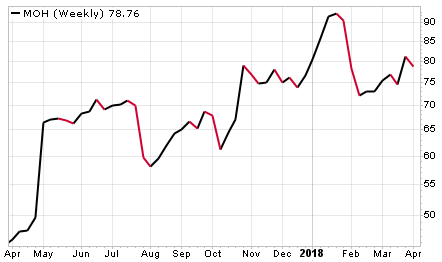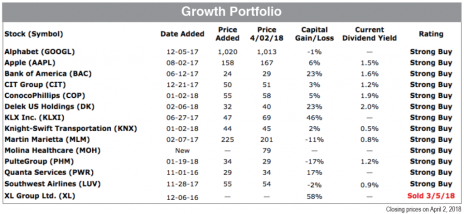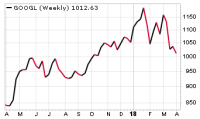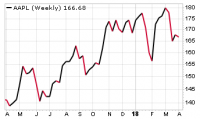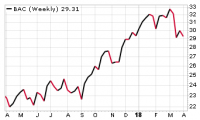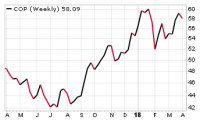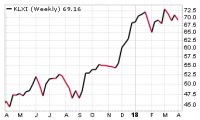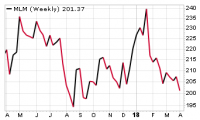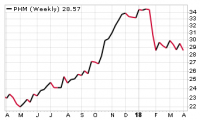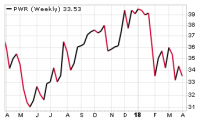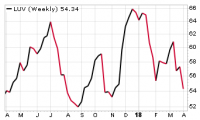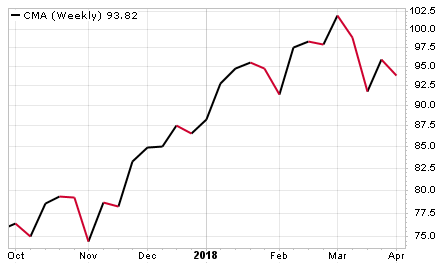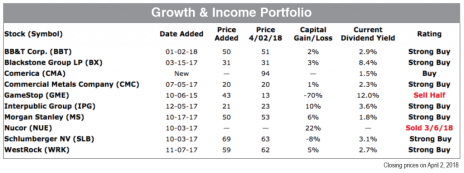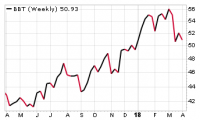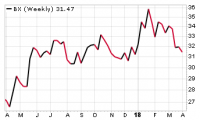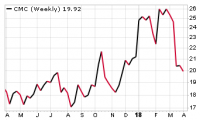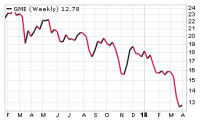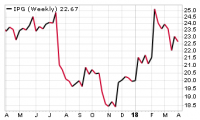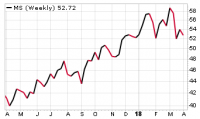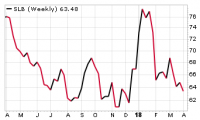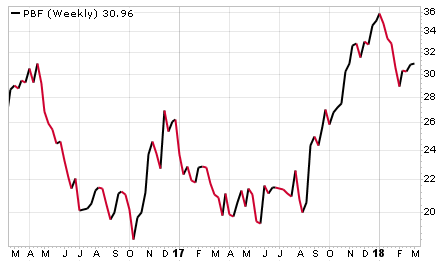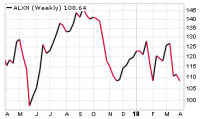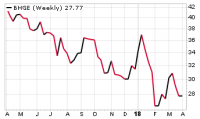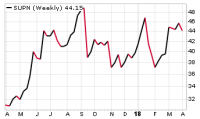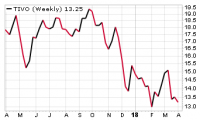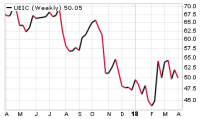I don’t tend to get very worked up about stock market volatility, and instead prefer to buy stocks during market dips. The S&P 500 keeps bouncing at 2,600, which means there’s good price support there that gives me confidence to buy low. Keep buying high quality stocks while the prices are low, so that your capital gain potential during market run-ups can get a head start!
Cabot Undervalued Stocks Advisor 418
[premium_html_toc post_id="147623"]
My Favorite New Stock Today
Today I’m introducing three new stocks to the Cabot Undervalued Stocks Advisor portfolios, including footwear manufacturer Skechers USA (SKX), which joins the Buy Low Opportunities Portfolio. I’m especially pleased to recommend Skechers because I love their products. As we age, few common physical changes or problems may greet us in our 30’s and 40’s: graying or thinning hair, joint problems in knees or shoulders, and foot pain. I’ve got the foot pain! If I described to you the degree to which the avoidance of foot pain controls my life and my wardrobe, you’d think I was exaggerating. Apparently, though, I’m not alone. Look at these headlines:
America’s Aching Feet – National Pain Report
Seventy-Two Percent of Americans Will Suffer With Foot Pain
51 Percent of Americans are Limited by Activity Due to Foot Pain
New Survey Reveals Majority of Americans Suffer from Foot Pain
First and foremost, I can’t wear “heels”—the classic women’s business footwear. They’re just not an option. I have to prioritize my footwear choices over every other wardrobe consideration in order to avoid serious and chronic foot pain. I even have to avoid walking barefoot!
For many years, I would head over to DSW (the retail shoe warehouse chain) to buy comfortable shoes that didn’t look like athletic sneakers. My choices were always limited, and I’d end up purchasing white Keds. More recently, I visited DSW, and there were dozens of comfortable shoe choices with floral, funky, and geometric designs! I’m thrilled that my shoes can be pretty again! Who makes these awesome shoes? Skechers USA! And lucky for you, their stock presents an excellent and outsized capital gain opportunity right now. Read more about Skechers below, in the Buy Low Opportunities Portfolio. (p.s. When I’m willing to cheat and accept some temporary foot pain, I wear cowboy boots. After all, I live in Colorado!)
MORE ON BANK STOCKS…
Last week, Mike Mayo at Wells Fargo echoed my bullish stance on banks in a CNBC video, specifically favoring BB&T Corp. (BBT) among large-cap banks. “Goliath is winning. The largest banks are seeing a 25-year structural breakout and the benefits of scale.” Mayo discussed the low share prices among regional banks and recommended Zions Bancorp (ZION). I like Zion too. I also like First Horizon National Corp. (FHN) and Popular (BPOP), each of which has even better earnings growth, lower P/Es and bigger dividend yields than ZION. (Caveat: Use a stop-loss order on BPOP, just in case ongoing post-hurricane financial problems harm Popular’s profitability.) In addition, Mayo anticipates increased M&A activity in the sector, which echoes my recently-expressed opinion.
POSSIBLE NAFTA BREAKTHROUGH ON AUTOMOBILE RULES OF ORIGIN
After seven rounds of negotiations between the U.S., Mexico and Canada toward the goal of updating the original 1993 version of the North American Free Trade Agreement (NAFTA), most chapters within the agreement have been finalized. One major sticking point has been automobile rules of origin. Per the Washington Examiner, “NAFTA’s rules of origin cover the percentage of an automobile’s inputs, such as parts and labor, that come from the U.S., Mexico or Canada to have a car be deemed to be ‘made in America’ and qualify for duty-free shipping.”
U.S. Trade Representative Robert Lighthizer has been aiming for regional automobile content to be increased from 62.5% to 85%. The U.S. concern is that a high percentage of automobile components are sourced from Asia by the partner countries. Negotiations have been at an impasse, largely because 85% is a higher goal than Mexican trade representatives have been willing to consider.
Very recently, Ambassador Lighthizer made a new proposal that automobile workers in NAFTA countries earn a minimum of $15 per hour. The higher wages would contribute toward the value of automobile content, thus helping the revised NAFTA agreement reflect 85% North American automobile content. The general sense is that Canada will approve that wage proposal while Mexico will balk at the proposal, but that there’s room to negotiate the wage downward toward a level where Mexico can acquiesce, Mexican workers can see their wages lifted, and NAFTA negotiations can be completed.
While I cannot foretell how the finalization of NAFTA may affect any particular stocks, I know that trade negotiations are of interest to many investors, and I’m happy to bring you up to date on trade news when there’s something pertinent to report.
Send questions and comments to crista@cabotwealth.com.
Portfolio Notes
Be sure to review the Special Bulletin from March 29 in which I mentioned news, rating changes and/or price action on GameStop (GME).
Buy-Rated Stocks Most Likely* To Rise More Than 5% Near-Term:
Delek US Holdings (DK)
Molina Healthcare (MOH)
PBF Energy (PBF)
Skechers USA (SKX)
Supernus Pharmaceuticals (SUPN)
*I can review price charts and make an educated determination about what’s likely to occur, but I will sometimes be wrong. I cannot control the stock market; I can only guide you through it.
Today’s Portfolio Changes:
Comerica (CMA) joins the Growth & Income Portfolio as a Buy.
Molina Healthcare (MOH) joins the Growth Portfolio as a Strong Buy.
Skechers USA (SKX) joins the Buy Low Opportunities Portfolio as a Strong Buy.
Last Week’s Portfolio Changes:
Alphabet (GOOGL) moved from Hold to Strong Buy.
BB&T Corp. (BBT) moved from Buy to Strong Buy.
Delek US Holdings (DK) moved from the Buy Low Opportunities Portfolio to the Growth Portfolio.
GameStop (GME) moved from Strong Buy to Hold; then to Sell Half.
Interpublic Group (IPG) moved from Buy to Strong Buy.
Growth Portfolio
Growth Portfolio stocks have bullish charts, strong projected earnings growth, little or no dividends, low-to-moderate P/Es (price/earnings ratios) and low-to-moderate debt levels.
Featured Stock: Molina Healthcare (MOH)
Molina Healthcare rejoins the Cabot Undervalued Stocks Advisor portfolios today as both a capital gain opportunity and a potential buyout target. Molina is a managed healthcare operator that offers health information management solutions to nearly five million members who receive their care through Medicaid, Medicare, health insurance exchanges and other government-funded programs in fifteen states.
Important upcoming events include Molina’s annual Investor Day on May 31 and the announcement of new contract awards by Washington State on May 22. The Washington contract reprocurements are critical to the company, and can favorably influence current contract negotiations in other states. Molina has a 47% market share and a 15-year history of service in Washington.
Here’s a brief history of company news as it related to our most recent investment in MOH:
In February 2017, Molina Healthcare delivered a horrendous fourth quarter earnings report.
In May 2017, the Board of Directors ousted the CEO and CFO (each with the surname Molina). The company immediately implemented a CEO search, and a restructuring plan that focused on multi-year cost savings and improved competitiveness in the Medicaid market.
I added MOH to the Buy Low Opportunities Portfolio in August 2017 when the share price dipped to 59. My price target was 80, where the stock had last traded in mid-2015.
In October 2017, it was announced that former Aetna CFO and Hanover Insurance Group CEO Joseph Zubretsky would join Molina as its new CEO.
In early November 2017, Molina reported excellent third quarter results. The market was pleased with the revenue numbers, restructuring progress and the 2018 outlook. The share price surged to my price target, and I promptly sold MOH for a 34% capital gain.
2017 was a difficult year for the company, and Molina ended up reporting a large net loss of ($7.61) per share. Fortunately, profitability has returned. The consensus earnings estimate for 2018 stood at $2.83 per share back in October, and has been steadily rising for five months. At this point, analysts expect Molina to achieve earnings per share (EPS) of $3.70 and $4.46 in 2018 and 2019. The stock does not pay a dividend, and the debt levels are fair—not low and not high.
MOH has a market capitalization of just $4.9 billion, making it an easy buyout target for larger health insurers, alternative asset managers or even huge American corporations that want to lower their employee healthcare costs.
In January 2018, Amazon (AMZN), JPMorgan Chase (JPM) and Berkshire Hathaway (BRK) announced a partnership aimed at reducing their companies’ healthcare costs and improving services for their 1.2 million employees. While the world waits to see how that partnership will unfold, Wal-Mart (WMT) is apparently not going to sit on the sidelines. In recent days, rumors emerged that Wal-Mart might acquire health insurer Humana (HUM), in an apparent move to bring healthcare in-house and lower costs. Humana’s market capitalization was $37 billion last week, prior to acquisition talks. If a big company can spend well over $37 billion to acquire Humana, imagine how easy it would be for another big company to spend less than $10 billion to acquire Molina Healthcare!
Every now and then, something big changes in our world. It might be a change in politics, education trends, a healthcare breakthrough or the climate. In 2018, the writing is on the wall: American corporations are done complaining about healthcare costs, and they’re ready to take action. This is going to change America’s health insurance landscape. It would probably be wise for investors to own at least one small- or mid-cap health insurance or medical supply company, so as to increase the odds that they can profit from new partnerships and buyouts within the healthcare sector.
Stocks generally rest for several months when they retrace former highs, as MOH did this past winter. The stock then rose to new all-time highs in January, and subsequently fell in synch with the recent stock market correction. Now that MOH is ready to trade above its former price resistance, I’m ready to make money on the stock again.
I waited for the share price to turn upwards before adding MOH to the Growth Portfolio. Therefore, I recommend that you buy MOH now. Strong Buy.
Updates on Growth Portfolio Stocks
Alphabet Cl. A (GOOGL) – Alphabet is the world’s largest internet company. Revenue is derived from Google’s online ads, with the balance coming from the sale of apps, digital content, services, licensing and hardware. Google announced a new service last week, Cloud Text-to-Speech, which converts blocks of text into speech using Alphabet’s DeepMind technology. The artificial speech is natural-sounding, and available in 12 languages. The application can be used within call centers, autos, TVs, robots, and audio books & podcasts.
I will consider GOOGL to be fairly valued when it retraces its January high near 1190, at which point I might sell to make room for a more undervalued stock to join the portfolio. I’m pleased that GOOGL maintained very firm price support at 1000 during this year’s stock market correction. There’s room within the current trading range for short-term traders to make 13% profit. Strong Buy.
Apple (AAPL – yield 1.5%) manufactures a wide range of popular communication and music devices. Apple is an undervalued growth stock, expected to see EPS increase 24.3% in fiscal 2018 (September year-end). I expect AAPL to rise to its March high at 182 in the short term, with additional capital gains in 2018. Strong Buy.
Bank of America (BAC – yield 1.6%) was featured last week in this Barron’s article, Banks: 4 Stocks That Can ‘Quietly Outperform’. The Oppenheimer analyst in the article also recommended:
CIT Group (CIT), which is in our Growth Portfolio; Goldman Sachs (GS), which is projected for just 10% EPS growth in 2018 and 2019; and Citigroup (C), an excellent undervalued growth stock, but I’m already overweighted in large-cap banks.
Bank of America is planning to grow its wealth management business by opening 600 new Merrill Edge centers and hiring 300 new financial solutions advisors in the next two years. Merrill Edge serves clients who have up to $250,000 in investable assets, and currently manages $184.5 billion in assets.
BAC is a significantly undervalued growth stock, expected to see EPS grow 37.2% in 2018. Profits are enhanced by rising interest rates, more so than at other financial companies. There’s 10% upside as BAC retraces its March high near 33, with additional capital gains in 2018. Buy BAC now. Strong Buy.
CIT Group (CIT – yield 1.2%) operates both a bank holding company and a financial holding company that provide financing, leasing and advisory services to small and middle market businesses, consumer markets, and the real estate and railroad industries. CIT was featured last week in Barron’s article, Banks: 4 Stocks That Can ‘Quietly Outperform’. Consensus earnings estimates have been rising steadily in recent months, with CIT now expected to see EPS grow 32.9% and 20.3% in 2018 and 2019. The corresponding P/Es are 12.6 and 10.5. I expect CIT to rise to its March high at 56 in the short term, with additional capital gains in 2018. Buy CIT now. Strong Buy.
ConocoPhillips (COP – yield 1.9%) is a global energy exploration and production company. The company is having a year of huge earnings growth, followed by a slow-growth year in 2019. (Consensus estimates for both years continue to rise.) Last week, Citigroup raised its price target on COP from 63 to 70. I expect COP to surpass its January high at 60 rather soon and intend to sell COP after the next run-up. Strong Buy.
Delek US Holdings (DK – yield 2.0%) is a diversified downstream energy company and a very undervalued small-cap stock. Analysts expect EPS to grow 113% in 2018, with continued aggressive growth in subsequent years. DK could appeal to investors who have a focus on value, aggressive growth or dividend income. DK began reaching new all-time highs in mid-March, and continues climbing. Buy DK now and buy more on dips. Strong Buy.
KLX Inc. (KLXI) is an undervalued, small-cap aggressive growth stock in the aerospace and energy service industries. In late December 2017, KLX announced that it hired Goldman Sachs to represent the company after receiving inquiries from interested parties about possibly buying all or part of KLX. KLX is undervalued, and expected to see 2019 EPS grow 34.3%. The stock began reaching new all-time highs in March, followed by a small pullback. After the next run-up, I’m likely to move KLXI to Hold and leave it there until we receive definitive news about M&A activity. Buy KLXI now. Strong Buy.
Knight-Swift Transportation Holdings (KNX – yield 0.5%) is a truckload carrier formed from the September 2017 merger between Knight Transportation and Swift Transportation Company. Consensus earnings estimates rose last week. The market now expects EPS to grow 66.7% and 20.0% in 2018 and 2019. KNX is an undervalued mid-cap stock. KNX rose to new all-time highs this year, then pulled back near 45 with the weak market in late March. Buy KNX now. Strong Buy.
Martin Marietta Materials (MLM – yield 0.8%) is a supplier of crushed stone, sand, gravel, cement, concrete and asphalt. This aggressive growth stock is fairly valued. MLM has been resting at strong price support near 200. In the coming months, I expect MLM to rise to its January high at 240. At that time, I plan to make room for a portfolio stock that’s more undervalued. Buy MLM now. Strong Buy.
PulteGroup (PHM – yield 1.2%) is a U.S. homebuilder and a very undervalued aggressive growth stock. The consensus 2018 EPS projection is $3.09, reflecting 50% year-over-year growth. PHM has been resting at strong price support near 28.5. In the coming months, I expect PHM to rise to its January high of 35, with additional capital gains in 2018. Buy PHM now. Strong Buy.
Quanta Services (PWR) provides specialized infrastructure and network services to the electric power, oil and natural gas industries. Consensus earnings estimates reflect 30.5% EPS growth in 2018, and the stock is undervalued. PWR has been resting at strong price support near 33.5. In the coming months, I expect PWR to rise to its January high of 40, with additional capital gains in 2018. Buy PWR now. Strong Buy.
Southwest Airlines (LUV – yield 0.9%) is the largest U.S. domestic air carrier, transporting over 120 million customers annually to over 100 locations in the U.S., Central America and the Caribbean. Based on recent statements by Warren Buffett, the investment world is speculating that Berkshire Hathaway (BRK) might purchase Southwest Airlines…the entire company. Analysts expect Southwest’s EPS to grow 40.3% in 2018, and the P/E is just 11.7. The stock is low within its trading range, offering a 15% capital gain when LUV returns to its January high of 66, with additional capital gains in 2018. Buy LUV now. Strong Buy.
Growth & Income Portfolio
Growth & Income Portfolio stocks have bullish charts, good projected earnings growth, dividends of 1.5% and higher, low-to-moderate P/Es (price/earnings ratios), and low-to-moderate debt levels.
Featured Stock: Comerica (CMA – yield 1.5%)
Comerica (CMA) joins the Growth & Income Portfolio today due to a special situation that could deliver both capital gains and an outsized dividend increase. But first, some basics about the company. Comerica is a financial services company engaged in domestic and international business banking & lending, wealth management and consumer services. The company is based in Dallas, TX.
Comerica’s income naturally increases as interest rates rise, enhanced by the company’s large number of variable rate loans to businesses and consumers. Comerica could additionally profit from the U.S. Senate’s bipartisan “Economic Growth, Regulatory Relief, and Consumer Protection Act” (S.2155), which intends to relieve some banks from “systemically important financial institution” (SIFI) status.
The company is in the midst of a restructuring plan through 2020 in which it’s cutting expenses, reducing loan loss provisions and expanding net interest margins. Comerica’s earnings per share (EPS) rose 77.6% in 2017, from $2.68 to $4.76, and are expected to rise another 36.8% and 11.4% in 2018 and 2019. The 2018 price/earnings ratio (P/E) is quite low in comparison to the EPS growth rate, at 14.7.
CMA has a $16 billion market capitalization and heavy institutional ownership. It’s widely believed that there will be a surge in M&A activity within the banking industry in the coming years, and CMA could certainly become a buyout target.
Here’s the important news. Comerica announces a dividend increase each year in late April (and sometimes twice per year). There were three dividend announcements in 2015 and 2016, each delivering 4–5% increases. Then in 2017, Comerica announced two consecutive quarterly dividend increases of 11–15% each. Importantly, while many banks announced outsized dividend increases since the new tax laws were implemented, including BB&T Corp. (BBT) in the Growth & Income Portfolio, Comerica has not announced an increase since July 2017. Therefore, we could see a big dividend boost later this month, combining a normally-attractive annual dividend increase with an additional enhancement related to the new tax laws.
Comerica’s earnings growth for 2019 is projected to be 11.4%, which is below my usual 15% requirement, although I’m very aware that earnings estimates are rising throughout the financial sector. I’m therefore giving CMA a Buy recommendation, rather than a Strong Buy, but I just want to make it clear that I have no reservations about investors’ likelihood of earning capital gains in the stock.
The price chart is relatively bullish. CMA rose to new all-time highs in January, pulled back with the stock market correction, rose to new highs again in both February and March, then had another pullback. Buy CMA now to take advantage of the bullish price action that could easily be enhanced by a late-April, potentially attention-grabbing dividend announcement. Buy.
Updates on Growth & Income Portfolio Stocks
BB&T Corp. (BBT – yield 2.9%) is a 145-year-old financial holding company with $222 billion in assets and 2,100 financial centers that serve businesses and individuals. Last week, Wells Fargo raised its price target on BBT to 63 and its rating to outperform; while B Riley FBR analyst Steve Moss raised his price target to 59 and his rating to buy. Consensus earnings estimates rose last week, now reflecting 41.2% and 8.4% growth in 2018, and the current P/E is 13.2. If the 2019 number continues to rise, I’ll keep the stock beyond its January high of 56. Strong Buy.
Blackstone Group LP (BX – yield 8.4%) is the world’s largest and most diversified alternative asset manager with $434 billion in client assets. The company raises tens of billions of dollars from investors and deploys the capital into private equity, lower-rated credit instruments, hedge funds and real estate. Analysts expect Blackstone’s economic net income (ENI) to grow 11.0% in 2018, and the stock is very undervalued. In the coming months, I expect BX to rise to its January high near 36. Strong Buy.
*The payout varies each quarter, with the total of the last four announced payouts yielding 8.4%.
Commercial Metals Company (CMC – yield 2.3%) is a recycler and manufacturer of steel and metal products, including rebar and fence posts. CMC is an extremely undervalued aggressive growth stock. Wall Street expects EPS to grow 93% and 60% in 2018 and 2019 (August year-end), with corresponding P/Es of 14.9 and 9.3.
As I mentioned last week, recent news on steel tariffs specifically favors U.S. rebar products, causing CMC and Nucor (NUE) to stand out as the companies most likely to benefit from new tariffs. A recently negotiated agreement on quotas of imported steel products from South Korea serves to reiterate the benefit to U.S. rebar production and pricing. South Korea agreed to a tariff-free quota of 70% of its previous average three-year imported steel volumes, with 25% tariffs applied on excess volumes. The general sense is that similar agreements will be made with other countries that export steel products to the U.S., giving even more advantage to U.S. rebar pricing than there would have been without the import quotas.
There’s 26% upside when CMC returns to its March high of 26. Strong Buy.
GameStop (GME – yield 12.0%) is a retailer of games, collectibles and technology; with additional ventures in the entertainment field. The company is going through a multi-year shift in product emphasis, to which the stock has reacted poorly. On March 29, I sent a Special Bulletin regarding the fourth quarter earnings report, and suggested that investors sell half their shares. Sell Half.
The Interpublic Group of Companies (IPG – yield 3.6%) is a large conglomerate of advertising, marketing, communications and public relations companies serving all global markets. IPG is an undervalued growth & income stock with an attractive rising annual dividend. The company is expected to see 2018 EPS grow 22.0%. (Earnings growth slows in 2019.) In the coming months, I expect IPG to rise to its February high at 25, and to rise further in 2018. Strong Buy.
Morgan Stanley (MS – yield 1.8%) is a major U.S. investment bank and wealth manager, and an undervalued, large-cap growth stock. Analysts are expecting EPS to grow 25.8% in 2018. I expect MS to rise to its March high at 59 in the short term, with additional capital gains in 2018. Strong Buy.
Schlumberger (SLB – yield 3.1%) is the world’s largest oilfield service company. The number of U.S. rigs drilling for crude oil and natural gas decreased by two last week to a total of 993. Analysts are expecting 2018 EPS to grow 44.7%, and the stock is undervalued. Subsequent years’ numbers also reflect earnings growth in the 44%-46% range. I expect SLB to rise to its January high of 79, with additional capital gains in 2018. Strong Buy.
WestRock Company (WRK – yield 2.7%) is a global packaging and container company. Consensus estimates point to revenue increasing 10.1% in 2018 and EPS growing 51.9%. The P/E is just 16.1. Amusingly, the two downward spikes of the February and March stock market corrections make the WRK price chart give the visual appearance of a Rorschach test. That’s fine with me—patterns are good, chaos is bad. I expect WRK to rebound to its January high at 70, with additional gains this year. Strong Buy.
Buy Low Opportunities Portfolio
Buy Low Opportunities Portfolio stocks have neutral charts, strong projected earnings growth, low-to-moderate price/earnings ratios (P/Es) and low-to-moderate debt levels. (Dividends are not a portfolio requirement, but some of the stocks will have dividends.) Investors should be willing to wait patiently for these stocks to climb.
Sometimes a stock in the Buy Low Opportunities Portfolio produces good capital gains and the share price is no longer low, yet the stock remains an attractive investment. Those stocks will then be moved into the Growth Portfolio or the Growth & Income Portfolio.
Featured Stock: Skechers USA Inc. (SKX)
Skechers USA is an apparel company that designs and manufactures affordable footwear for people of all ages. The company is based in California, and sells its products in over 160 countries and territories in Asia, Europe, the Middle East and the Americas, through wholesale, retail and e-commerce venues. Retailers include department and specialty stores, and both wholly-owned and franchised Skechers stores. Skechers also licenses its brand name for a variety of merchandise, including apparel, eyewear, leather goods and accessories.
Skechers is growing faster than its footwear competitors. Revenue grew 16.9% in 2017 to $4.2 billion, led by its international wholesale division, which experienced 24.3% growth. Wall Street expects revenue to increase 11.9% and 10.6% in 2018 and 2019.
Earnings per share (EPS) rose 13.4% in 2017, and are expected to grow aggressively at 28.1% and 18.0% in 2018 and 2019. Corresponding price/earnings ratios (P/Es) are 17.1 and 14.5, much lower than the earnings growth rates.
The company announced a $150 million share repurchase authorization in February 2018, which expires in three years.
SKX is an undervalued mid-cap growth stock, with a market capitalization of $6.1 billion. The company operates with an extremely low long-term debt-to-capitalization ratio of 3.5%. If a larger company becomes interested in making a profitable and financially sound apparel acquisition, Skechers USA would be an attractive target.
It’s worth noting that SKX has a 98% composite rating from Investor’s Business Daily, meaning the stock surpasses 98% of all other stocks in terms of key performance metrics and technical strength.
After trading sideways for well over a decade, SKX began reaching new highs in 2014 and peaked near 53 in 2015. Prospects of strong annual EPS growth slowing to a crawl in 2016 caused a multi-year pullback in the share price. Now that attractive EPS growth has resumed, and is projected to continue for several years, the share price is rising again.
SKX traded quietly between 38 and 41.5 this year, showing more strength than the broader stock market. There’s 35% upside as SKX retraces its highs from 2015, at which point I expect the stock will be both fully valued, and meeting significant price resistance. Strong Buy.
Updates on Buy Low Opportunities Portfolio Stocks
Alexion Pharmaceuticals (ALXN) is a biopharmaceutical company that researches and manufactures treatments of severe and rare health disorders. Analysts expect 2018 and 2019 EPS to grow 16.7% and 23.7%. The corresponding P/Es are 16.3 and 13.2. I expect ALXN to rebound to its March high of 127, with lots more capital gain potential this year. Strong Buy.
Baker Hughes a GE Co. (BHGE – yield 2.6%) offers products, services and digital solutions to the international oil and gas community. The number of U.S. rigs drilling for crude oil and natural gas decreased by two last week to a total of 993. Analysts expect EPS to grow 86% and 96% in 2018 and 2019, and the stock is undervalued. I expect BHGE to rise to its January high of 37, with additional capital gains in 2018. Strong Buy.
Chipotle Mexican Grill (CMG) is a growing restaurant chain, and an aggressive growth stock. Analysts expect EPS to grow 28.5% per year in 2018 and 2019. CMG appears capable of rising past price resistance at 345 in the near term and heading toward about 360. Hold.
PBF Energy Inc. (PBF – yield 3.5%) is one of the largest U.S.-based petroleum refining and marketing companies. PBF serves the U.S., Canada and other international locales. Wall Street expects aggressive EPS growth rates of 167% and 28.3% in 2018 and 2019, and the stock is undervalued. One major Wall Street bank gives PBF a sum-of-the-parts valuation of $52. PBF is rising toward its January high at 36. Short-term traders should exit near 36, and everybody else should hold on for additional capital gains, which could come immediately. Buy PBF now and buy more on dips. Strong Buy.
Supernus Pharmaceuticals (SUPN) focuses on the development and commercialization of products for the treatment of central nervous system diseases and psychiatric disorders, including epilepsy and ADHD. Analysts expect EPS to grow 47.6% in 2018, with continued aggressive growth in subsequent years. The stock is undervalued. SUPN has upward momentum, and could reach 50 quite soon, where it last traded in September 2018. Buy.
TiVo (TIVO – yield 5.3%) — Last week, TiVo inked a deal with Tru Optik in which Tru Optik’s OTT Marketing Cloud will access TiVo’s linear viewership data to enhance its audience targeting and measurement services. TiVo is an entertainment technology company that joined the Buy Low Opportunities Portfolio specifically because it’s a takeover target. (See the Special Bulletin from March 5.) I expect patient investors to be rewarded with capital gains in 2018, either from a buyout offer or from price increases related to the current low valuation. Expect volatility. Strong Buy.
Universal Electronics (UEIC) is a manufacturer and cutting-edge world leader of wireless remote control products, software, and audio-video accessories for the smart home, with a strong pipeline of new products. UEIC is an undervalued micro-cap growth stock, with minimal debt on the balance sheet. Analysts expect EPS to grow 21.7% in 2018. Keep in mind that small, financially-strong companies make attractive takeover targets. I expect UEIC to rebound to 66, where it last traded in October 2017. Strong Buy.
[premium_html_footer]
Send questions or comments to crista@cabotwealth.com.
Cabot Undervalued Stocks Advisor • 176 North Street, Salem, MA 01970 • https://cabotwealth.com//
YOUR NEXT CABOT UNDERVALUED STOCKS ADVISOR ISSUE IS SCHEDULED FOR May 1, 2018
Cabot Undervalued Stocks Advisor is published by Cabot Wealth Network, an independent publisher of investment advice. Neither Cabot Wealth Network nor its employees are compensated in any way by the companies whose stocks we recommend. Sources of information are believed to be reliable, but they are in no way guaranteed to be complete or without error. Recommendations, opinions or suggestions are given with the understanding that subscribers acting on information assume all risks involved. Copyright © 2018 - COPYING AND/OR ELECTRONIC TRANSMISSION OF THIS NEWSLETTER IS A VIOLATION OF THE U.S. COPYRIGHT LAW. For the protection of our subscribers, if copyright laws are violated by any subscriber, the subscription will be terminated.
[/premium_html_footer]


